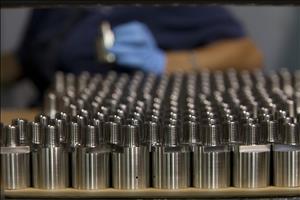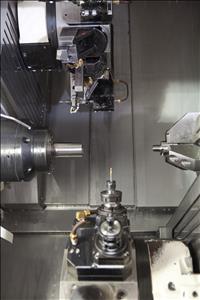Ask Michael Olano, president of Dynomach Inc., how to be a profitable high-volume production shop, and his answer will be self-contained single-cell automation – more specifically, twin-spindle machines outfitted with bar feeders and automatic parts catchers.
For Dynomach, in Port Allen, La., twin-spindle machine technology allows the 14-person shop to cost effectively keep pace with continuously increasing job volumes. The machines not only provide increased capacity, they virtually eliminate work in progress to help boost the shop’s cash flow. Parts no longer move from one machine to the next for various operations. Instead they are loaded once, get machined complete in a single setup and then unloaded.
When it first opened its doors 1979, Dynomach repaired pumps and manufactured a variety of parts. Business continued to grow, and with it production volumes. Currently, lot sizes run anywhere from two prototype parts to 8,000 pieces for regularly occurring orders. And, at any given time, the shop can have at least 10, or more, large blanket orders in active production as well as its other jobs.
 The shop now produces mostly control valve components used in various industries, including oil and gas, oceanographic mapping and chemical. Approximately 90 percent of these parts are made from 316 stainless steel and require milling, turning, drilling, treading and thread milling operations. They range in size from 0.250” to 3” in diameter and from 2” to 5” long with tolerances that must be held between 0.0005” to 0.001”.
The shop now produces mostly control valve components used in various industries, including oil and gas, oceanographic mapping and chemical. Approximately 90 percent of these parts are made from 316 stainless steel and require milling, turning, drilling, treading and thread milling operations. They range in size from 0.250” to 3” in diameter and from 2” to 5” long with tolerances that must be held between 0.0005” to 0.001”.
According to Olano, the progression from multiple machines to single-cell twin-spindle automated part processing occurred in stages, each involving the acquisition of a different machine type offering different, yet production-enhancing, processes and part size capabilities. Four such twin-spindle machines are the shop’s INTEGREX-III 200 S 5-Axis Multi-Tasking Machine, its MULTIPLEX 6200Y Turning Center, its HYPERQUADREX 200 MSY Turning Center and a QUICK TURN NEXUS 250 MSY Turning Center – all from Mazak Corporation and acquired through Mazak distributor Dixie Mill in New Orleans.
The INTEGREX-III 200 S, with 5-axis machining capability, features a 12,000-rpm, 25-hp milling spindle with 225-degree range of B-axis travel in addition to its two turning spindles. Both turning spindles, equipped with 8” chucks, provide C-axis contouring in 0.0001-degree increments. While the main has a through hole for automated processing, the machine is equipped with a 40-tool automatic tool changer, bar feeder and automatic parts catcher.
Dynomach’s HYPERQUADREX 200 MSY and MULTIPLEX 6200Y both feature twin turning spindles and twin tool turrets that have Y-axis travel capability for off-centerline work. However, the tool capacities and layout of those twin turrets differ between the two machines.
The HYPERQUADREX 200 MSY has one turret above and another below its spindle centerline. Thus, each turret can travel independently to serve either main or secondary spindle, or both upper and lower turrets can simultaneously work at the same spindle. The turrets each accommodate 12 tools and allow for live rotary tools in any position. With the MULTIPLEX 6200Y, its two 16-position turrets are each paired exclusively to one corresponding spindle.
Dynomach’s QUICK TURN NEXUS 250 MSY features twin spindles with live tool capability and Y-axis off-centerline functionality. The machine’s single turret holds 12 tools and is equipped with a 4,500-rpm, 7.5-hp rotary tool spindle for multi-tasking operations such as milling, drilling and tapping.
To create self-contained automated cells, Dynomach equipped all these machines with bar feeders for continuous operation. Additionally, its HYPERQUADREX 200 MSY includes a workpiece unloader and parts conveyor, and its MULTIPLEX 6200Y has an added parts unloading package.
As the shop progressed from one type of machine tool technology to the next, so did several of its parts in an effort to continuously reduce cycle times. One control valve component the shop had been doing for 15 years, according to Olano, comes immediately to mind. For this particular part, the shop was able to slash its 60-minute completion time down to only 15 minutes and eliminate having to process it using multiple machines.
At first, the shop machined the part using two lathes and a mill. The shop then moved the job over to its INTEGREX-III 200 S and immediately cut cycle time in half to only 30 minutes and processed the part complete using one machine. Then, because the part involved mostly turning operations, the shop decided to machine it on the MULTIPLEX 6200Y and was able to reduce process time down to 25 minutes. Then when Dynomach acquired the HYPERQUADREX 200 MSY, the job moved to that machine where process time dropped to 15 minutes. And for this component’s mating parts, the shop made the same transitions to go from 50-minute processing times, to 30 minutes, to 17 minutes and finally down to only 10 minutes.
Dynomach is able to shorten part cycle times and achieve automated part processing through the Done-In-One capabilities of its Mazak machines. With sequential processing, Dynomach will complete a part’s front-end work in the first spindle. The part will then transfer to the second spindle in a coordinated hand off for its back work. While that happens, a new part loads into the first spindle, and the process repeats with parts coming off machines completely finished. 
Tool capacity is key
Olano explained that tool capacity is key to the shop’s self-contained single-cell automation strategy. In fact, he said the need for increased tool capacity and advanced milling capabilities drove the acquisition of the INTEGREX-III 200 S. The shop had to machine a part that involved flats and holes and a contoured shape. But its existing machines at the time lacked the necessary axis travel and tool capacity for the particular part that required 31 tools during processing. The INTEGREX-III 200 S not only provided more than enough room for the tooling in its tool magazine, it expanded the shop’s part-processing versatility with the addition of 5-axis machining capability.
“When it comes to tooling capacity, more is always better, which is why when we found out Mazak offered a 16-position turret option, we got it for our MULTIPLEX 6200Y,” said Olano. “We needed to make 200 parts per week for an 8,000-piece annual blanket order. Our first thought was two dedicated turning machines and a standalone robot. But with a 32-tool capacity, along with twin-spindles and twin-turrets, we automated processing and now machine the parts complete with our one MULTIPLEX 6200Y, and without the added cost of a robot as well.”
In the case of its HYPERQUADREX 200 MSY, Dynomach discovered that 12-station turrets (24-tools total) were more than enough. The reason being that the machine’s turrets can work at either of its turning spindles – two turrets working at the main or second spindle simultaneously and on the same workpiece. This capability, according to Olano, also makes it much easier to achieve processing balance, which is critical to obtaining the shortest possible part cycle times on twin-spindle, twin-turret machines.
Balance equals shortest cycle times
 “On twin-spindle twin-turret machines, the longest operation cycle time becomes a part’s overall cycle time,” said Olano. “This means that the spindle in which a part spends the most time is the one that determines cycle time. So to achieve the shortest cycle times, there must be a balance between the two spindles, and we obtain this balance by dividing our part operations, as equally as possible time-wise, between a machine’s two spindles.”
“On twin-spindle twin-turret machines, the longest operation cycle time becomes a part’s overall cycle time,” said Olano. “This means that the spindle in which a part spends the most time is the one that determines cycle time. So to achieve the shortest cycle times, there must be a balance between the two spindles, and we obtain this balance by dividing our part operations, as equally as possible time-wise, between a machine’s two spindles.”
For instance, one drilled hole may require up to four separate tools at Dynomach, and to gain balance, according to Olano, the shop will first consider several factors – such as does the part geometry allow the hole to be drilled in either the main or second spindle, or are there multiple holes of the same size in the part and where are they located. If holes can be drilled in either spindle, the shop then decides – based on turret tool loads and affect on part cycle time – to either drill the holes during front-working operations or back-working ones.
However, he added that there are no steadfast rules to follow as to the best way to balance operations and tooling. It is basically trial-and-error, and shops have to keep testing different approaches to the same types of parts until they find a particular balance that works. And while at first achieving balance can be a challenge and a bit time consuming, the process gets easier and quicker the more a shop works with its twin-spindle twin-turret machine tools.
Machines such as HYPER QUADREX 250 MSY where turrets can work at either main or second spindles make achieving part-processing balance much easier because they provide more options. If there is an absurdly long cycle time at one spindle, shops can bring the other turret over to help shorten it.
To illustrate, Olano suggested considering a part that requires drilling with a 0.187”-diameter drill at both the part’s front and back ends. The drill could be stored in the machine’s main-spindle turret for the hole drilled during the front-end work of a part, but then that same turret would move to the second spindle and also drill the hole at the backside of the part. If a machine’s turrets were unable to work at either spindle, a shop would have to use two identical drills, one in each turret.
Olano pointed out that the MATRIX 2 CNC controls on the Mazak machines also contribute greatly to speeding up the process of determining how best to run a part for operational balance. The control provides simulation that shows the shop what turret will be working at which spindle and where there could be potential problems, all before running an actual part. Plus, the shop uses the simulation function to help in quoting jobs.
Mazak designed the MATRIX 2 to simplify multi-tasking operations for parts requiring off-center-line machining and angled drilling, milling or tapping. With the control, Dynomach also has the versatility to program parts using either conversational or EIA/ISO programming.
“The control really sold us,” commented Olano. “Mazak is the first machine tool company to continuously improve upon its programming systems. Plus, with the same control, every one in the shop can go from one Mazak to the next and run it.”
Olano explained that as the shop continues to shorten cycle times, it, in turn, opens up additional machine capacity. “With more capacity, our existing customers are giving us even more work. And as that demand increases, we will depend on our reliable and accurate Mazak’s for self-contained, single-cell automation to cost-effectively meet those surging production needs.”
